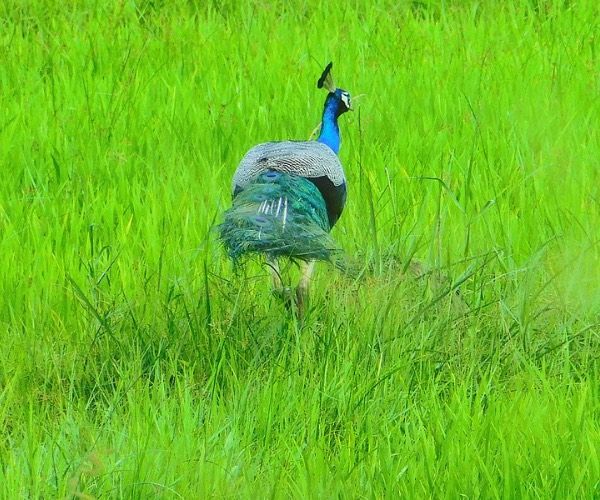
Aug 22 2022.
views 993

Crop damage is considered to be the biggest challenge faced by farmers in wildlife inhabited areas. Research conducted by the Hector Kobbekaduwa Agrarian Research Institute on crop damage done by wild animals in the Uva and Eastern provinces in 2019 shows that 30% of seasonal crops and 26% of permanent crops are damaged by wild animals in vulnerable areas. In other words, around 28% of the total harvest goes to waste due to damage done by animals. Animals such as peacocks, wild boars, toque macaques, monkeys, and parrots cause the most amount of damage in addition to elephants, porcupines, bats, rabbits, grey hornbills, jungle fowl, and crows. However, conservationists have been working on the ground to provide feasible solutions to mitigate the human-wildlife conflict over the years. But unfortunately, many of these proposals, and action plans have gathered dust on shelves. In a fresh attempt, the subject minister plans to implement measures to minimize crop damage done by animals and conservationists are keeping their fingers crossed.
Reintroducing predators, an ethical option
However, a fraction of conservationists aren’t convinced about the Ministry’s plans to minimize crop damage. “Usually subject ministers don’t have any knowledge about their subject and as a result, they will appoint a committee of experts and it turns out to be a waste of money,” opined Prof. Sampath Seneviratne, Professor of Zoology, Department of Zoology and Environmental Sciences, Faculty of Science, University of Colombo. “Second week into his appointment he becomes the most experienced person on the subject. Then they will appoint their family members and close friends to these committees... This is the sad reality of our country,” he alleged.

Pictured: Prof. Sampath Seneviratne
Prof. Seneviratne then spoke about managing peacocks and peafowls who are now considered to be a pest by farmers. “The peacock is an omnivore and it feeds on anything from fruits to grains to twigs of plants etc. In fact, it’s a biological vacuum cleaner and a big agricultural pest. If it enters the Sinharaja Forest it will feed on bird’s eggs and as such, it is a threat to endangered and critically endangered wildlife and a threat to small-scale agriculture. The main predators of peacocks are leopards and jackals. So one of the options is to bring the balance back and support larger predators such as mongoose, fishing cats, and leopards. We have plenty of plantations and an extensive network of paddy fields. By connecting these systems and providing jungle cats, and fishing cats with corridors that would help them move about will provide a solution to control the population of peacocks.”
He further said that supporting natural systems will help peacocks go back to where they were. “This can be done in a year or so. Compared to controlling monkeys, and elephants this is somewhat easier because we are not at war with predators of peacocks. But in order to do this the Agriculture, Wildlife departments, Mahaweli Authority, and other institutions should work together. On the short term, farmers can look at having deterrents to chase them away. By bringing back the carnivores their eggs will be removed. Deterrents by farmers will push them from critical habitats.”
Speaking about culling as a management practice, Prof. Seneviratne responded in the negative considering the religious and cultural concerns. However one of the reasons for the expansion of peacock territories is due to haphazard land clearances. “Extensive clearing of land takes place due to poor governance. Once unplanned land clearance is done, reversal is difficult. Therefore establishing corridors, identifying critical habitats is important to stabilize an unstable environment.”
Request to implement existing solutions
Even though crop damage done by elephants gets more prominence in the news, research studies indicate that only around 20% of crop damage is done by elephants. Shedding light on how the clearing of land could be done in a more sustainable manner, leading elephant researcher and former Director of the Department of Wildlife Conservation Dr. Sumith Pilapitiya said that currently, clearing land is done with little or no regard for wildlife needs because most of the land clearances are for unplanned or badly planned development activities. “Planning development should be based on a landscape basis. Then the developer or development agency is aware of the entire landscape and what is going on in the landscape. Then the development project can be planned taking care of the needs of the others using the landscape, be it humans or wildlife. There is no procedure in place to ensure that small-scale development follows such a planned approach. When authorization is required, most often the project is evaluated in isolation from the other users of the landscape. That is why we see an aggravation of human-wildlife conflict (HWC).”

Pictured: Dr. Sumith Pilapitiya
“In large-scale development projects where Environmental Impact Assessments (EIA) is required, the EIA is expected to study the project’s impacts on the landscape—both positive and negative. But even with such a statutory requirement in place, EIA is seen as a hurdle to the development project and poor analysis is undertaken with very little attention paid to the entire landscape. Most EIAs are limited to evaluating the direct impacts of the project rather than including a good analysis of the cumulative impacts. Therefore, many projects where EIA has been done also contribute to increasing HWC.”
“For example, if there is a project to rehabilitate tanks and reservoirs, the EIA will only examine the direct impacts of the rehabilitation. However, rehabilitation of tanks and reservoirs is done to ensure more water can be stored for use in agriculture. When there is more irrigation water, either the land area cultivated increases or the cultivations take place during both the Maha and Yala seasons. If more land comes under cultivation, more forest land may be cleared resulting in a reduction of habitat for wildlife. Then, wildlife starts encroaching on cropland, which results in an increase in conflict. In instances where lands are used only for a single cultivation per year, the fallow period becomes a wildlife habitat without any conflict as there are no people of cultivation during the fallow period. But with the availability of additional water from the rehabilitation of tanks, if there is an additional crop cultivated, there is a good chance that wildlife that grazed on the land when fallow will still come and then be tempted to raid crops. Unfortunately, virtually no EIA on tank rehabilitation looks at the HWC impacts that could arise as a result of more irrigation water.”
“The bottom line is if there is better analysis of the requirements of humans and wildlife within the landscape, a better-planned project will be implemented. This is how we ensure the sustainability of the development work,” he added.
When asked about suggestions he proposes to minimize crop damage done by elephants, Dr. Pilapitiya said that there is a National Action Plan for mitigation of the human-elephant conflict. “This plan was prepared by a Presidential Committee appointed at the request of the former President in 2020. A practical action plan with short-term, medium-term, and long-term actions have been proposed. The actions proposed are based on scientific information and studies as well as successfully implemented pilot projects. But after handing over the National Action Plan (NAP) to the former President in December 2020, absolutely nothing was done to implement the plan. Without trying to reinvent the wheel, the Government should implement the plan comprehensively.”
He said that community-based seasonal agricultural electric fences have been proposed in the NAP to protect crops. “These fences are erected by the farmer organizations and maintained by them. The Center for Conservation and Research (CCR) has around 50 such seasonal agricultural fences in the Wayamba and North Central Provinces that have been operating successfully for over 10 years. So there is a proven solution to minimize crop damage from elephants, which results in fewer elephants being killed or injured by farmers. But Sri Lanka lacks the political will to upscale and implement this solution.” My recommendation to the Government is that they not waste time developing another plan, but start implementation of the existing NAP,” Dr. Pilapitiya concluded.
Solutions to be implemented before the end of this year: Minister
When contacted, Agriculture, Wildlife, and Forest Resource Conservation Minister Mahinda Amaraweera said that a committee has been appointed with secretaries of both ministries to consult experts on the issue.

Pictured: Minister Mahinda Amaraweera
“We will take the final decision after having discussions with animal rights activists. We have instructed the Agrarian department to inform officers in every division to analyze the extent of crop damage. Animals such as monkeys, peacocks, pigs, porcupines, and giant squirrels are said to cause the most amount of damage. We are expediting the process to implement these measures before the end of this year.”
0 Comments